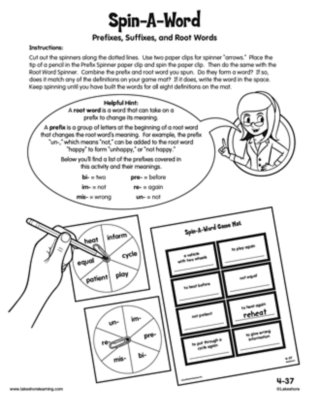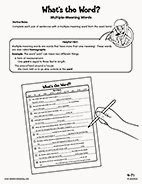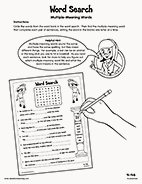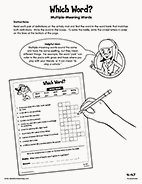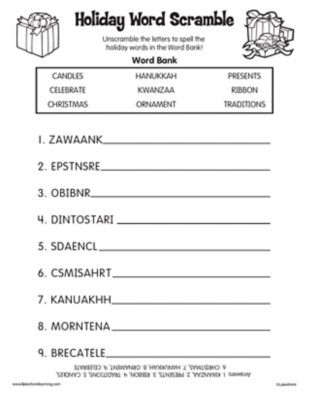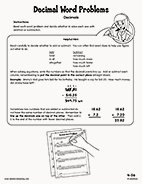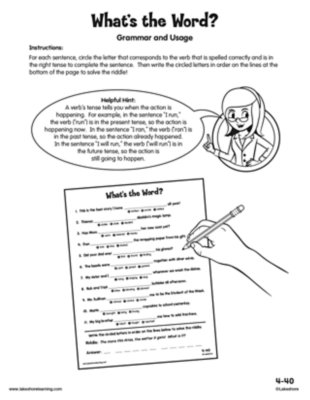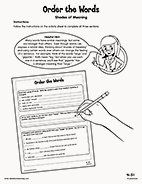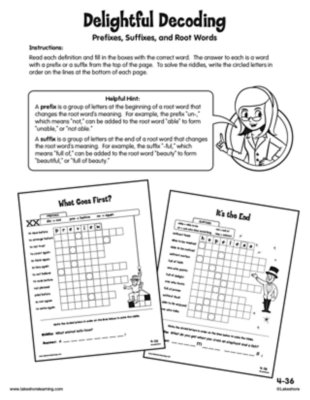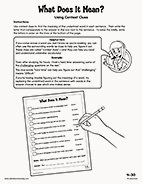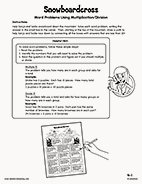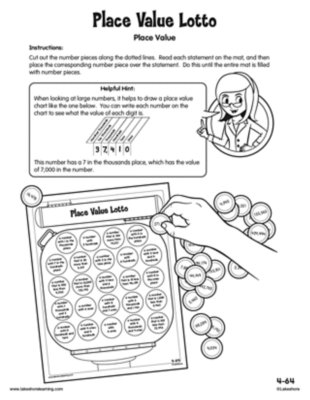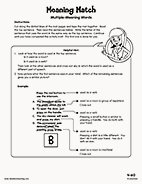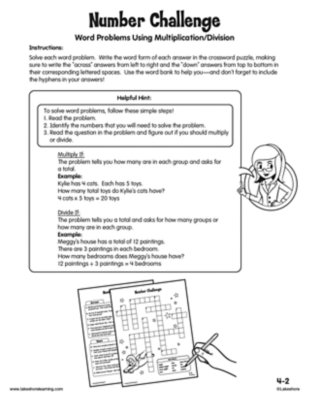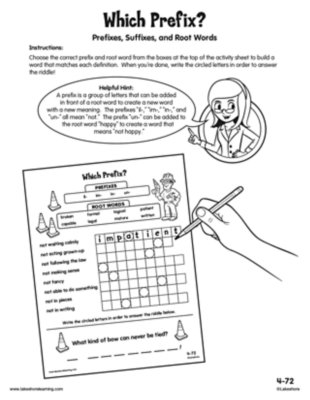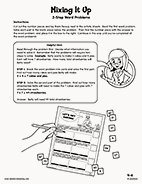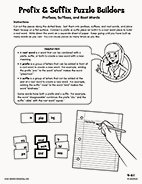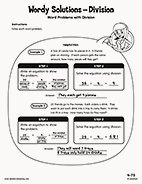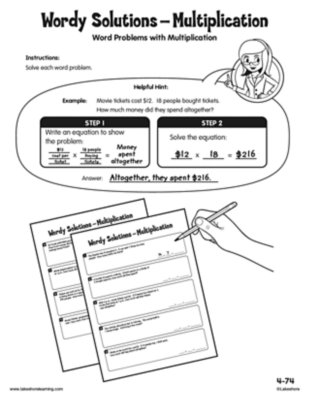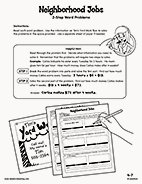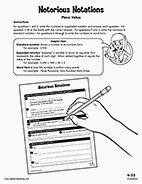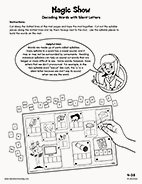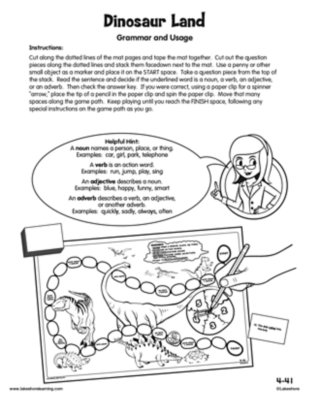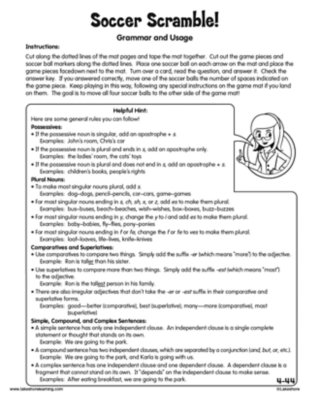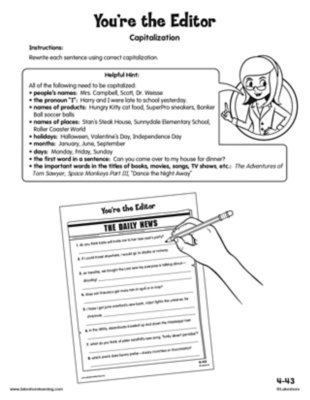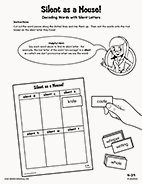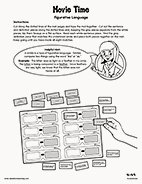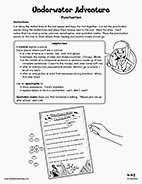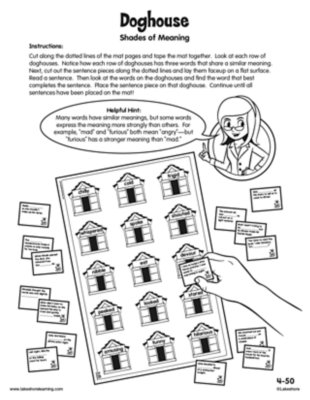Narrow by Grade
- Infant (0)
- Toddler (0)
- Preschool (0)
- Pre-K (6)
- Kindergarten (33)
- 1st (51)
- 2nd (55)
- 3rd (39)
- 4th (31)
- 5th (25)
- 6th & Up (0)
Grade 4th
Narrow by Age
- 0-18m (0)
- 18-36m (0)
- 3 yrs. (0)
- 4 yrs. (0)
- 5 yrs. (0)
- 6 yrs. (0)
- 7 yrs. (1)
- 8 yrs. (1)
- 9 yrs. (31)
- 10 yrs. (0)
- 11 yrs. & Up (0)
Age
31 results for "word"
When entering fourth grade, your child should be able to figure out the meaning of a word when a prefix or suffix is added to a familiar root word, such as figuring out what the word “unhappy” means based on the knowledge that “un-” means “not.”
View worksheetDuring fourth grade, your child will be asked to figure out the correct meanings of multiple-meaning words that appear in fourth-grade texts, such as knowing when the word “pitcher” refers to a container for pouring liquids or a person throwing a ball.
View worksheetWhen entering fourth grade, your child should be able to figure out the correct meanings of multiple-meaning words that appear in third-grade texts, such as knowing when the word “shower” refers to a rainstorm or a place to wash off.
View worksheetWhen entering fourth grade, your child should be able to figure out the correct meanings of multiple-meaning words that appear in third-grade texts, such as knowing when the word “shower” refers to a rainstorm or a place to wash off.
View worksheetDuring fourth grade, your child will learn to write fractions with denominators of 10 or 100 as decimals, such as writing 3/10 as 0.3 and writing 34/100 as 0.34. Your child will also learn to add and subtract amounts of money using decimals.
View worksheetWhen entering fourth grade, your child should know how to correctly use words in sentences and should know many rules of English grammar, including parts of speech, regular and irregular plural nouns, regular and irregular verbs, verb tenses, subject-verb agreement, sentence structure and more.
View worksheetWhen entering fourth grade, your child should be able to distinguish between shades of meaning among related words, such as “wondered,” “suspected,” “believed” and “knew.”
View worksheetWhen entering fourth grade, your child should be able to figure out the meaning of a word when a prefix or suffix is added to a familiar root word, such as figuring out what the word “unhappy” means based on the knowledge that “un-” means “not.”
View worksheetWhen entering fourth grade, your child should be able to use clues within a sentence to figure out the meaning of an unfamiliar word or phrase. For example, in the following sentence, the underlined portion provides a clue to what the word “aviary” means: The zoo’s aviary was filled with owls, bluebirds, parrots, parakeets and cuckoos.
View worksheetWhen entering fourth grade, your child should be able to use clues within a sentence to figure out the meaning of an unfamiliar word or phrase. For example, in the following sentence, the underlined portion provides a clue to what the word “aviary” means: The zoo’s aviary was filled with owls, bluebirds, parrots, parakeets and cuckoos.
View worksheetWhen entering fourth grade, your child should know how to solve word problems involving multiplication and division within 100.
View worksheetDuring fourth grade, your child will learn to identify the value of each digit in a multidigit number. Your child will also learn to read and write multidigit numbers in number, word and expanded form. For example, 765; seven hundred sixty-five; 700 + 60 + 5.
View worksheetDuring fourth grade, your child will be asked to figure out the correct meanings of multiple-meaning words that appear in fourth-grade texts, such as knowing when the word “pitcher” refers to a container for pouring liquids or a person throwing a ball.
View worksheetWhen entering fourth grade, your child should know how to solve word problems involving multiplication and division within 100.
View worksheetDuring fourth grade, your child will learn to use common, grade-appropriate Greek and Latin prefixes, suffixes and roots to figure out the meaning of a word. For example, “telegraph,” “photograph” and “autograph” all contain the Greek root “graph,” which refers to something that is written or drawn.
View worksheetWhen entering fourth grade, your child should know how to solve two-step word problems involving addition, subtraction, multiplication and division.
View worksheetDuring fourth grade, your child will learn to use common, grade-appropriate Greek and Latin prefixes, suffixes and roots to figure out the meaning of a word. For example, “telegraph,” “photograph” and “autograph” all contain the Greek root “graph,” which refers to something that is written or drawn.
View worksheetDuring fourth grade, your child will solve word problems that involve multiplication and division.
View worksheetDuring fourth grade, your child will solve word problems that involve multiplication and division.
View worksheetWhen entering fourth grade, your child should know how to solve two-step word problems involving addition, subtraction, multiplication and division.
View worksheetDuring fourth grade, your child will learn to identify the value of each digit in a multidigit number. Your child will also learn to read and write multidigit numbers in number, word and expanded form. For example, 765; seven hundred sixty-five; 700 + 60 + 5.
View worksheetWhen entering fourth grade, your child should be able to decode and spell multisyllable words and grade-appropriate irregularly spelled words.
View worksheetWhen entering fourth grade, your child should understand figurative language, such as idioms, and be able to distinguish between the literal and nonliteral meanings of words. For example, “It was a piece of cake!”
View worksheetWhen entering fourth grade, your child should know how to correctly use words in sentences and should know many rules of English grammar, including parts of speech, regular and irregular plural nouns, regular and irregular verbs, verb tenses, subject-verb agreement, sentence structure and more.
View worksheetWhen entering fourth grade, your child should know how to correctly use words in sentences and should know many rules of English grammar, including parts of speech, regular and irregular plural nouns, regular and irregular verbs, verb tenses, subject-verb agreement, sentence structure and more.
View worksheetWhen entering fourth grade, your child should remember to capitalize the appropriate words in titles, such as the names of books and movies. Your child should also remember to use commas in written addresses and with quotation marks to show when someone is speaking.
View worksheetWhen entering fourth grade, your child should be able to decode and spell multisyllable words and grade-appropriate irregularly spelled words.
View worksheetWhen entering fourth grade, your child should understand figurative language, such as idioms, and be able to distinguish between the literal and nonliteral meanings of words. For example, “It was a piece of cake!”
View worksheetWhen entering fourth grade, your child should remember to capitalize the appropriate words in titles, such as the names of books and movies. Your child should also remember to use commas in written addresses and with quotation marks to show when someone is speaking.
View worksheetWhen entering fourth grade, your child should be able to distinguish between shades of meaning among related words, such as “wondered,” “suspected,” “believed” and “knew.”
View worksheet